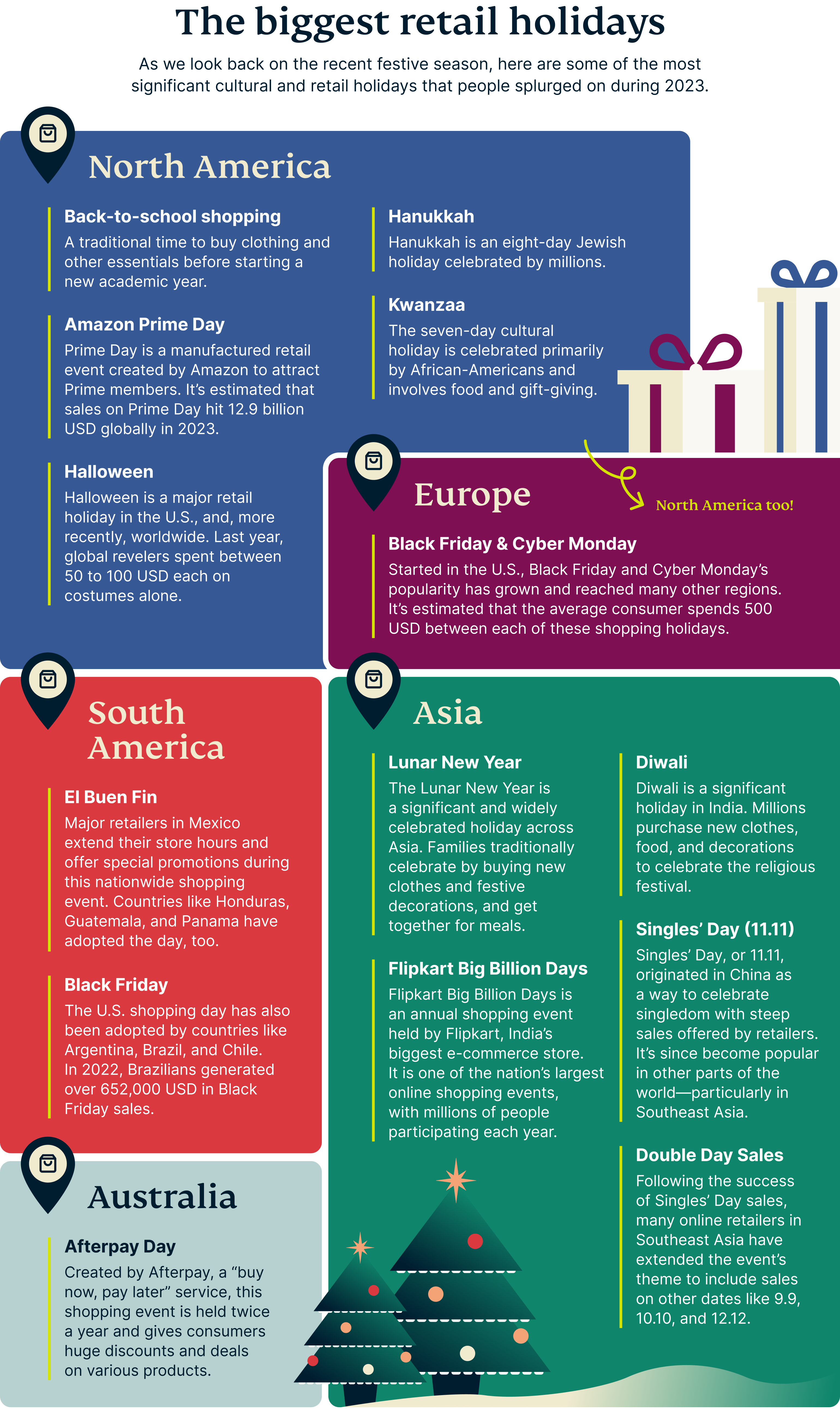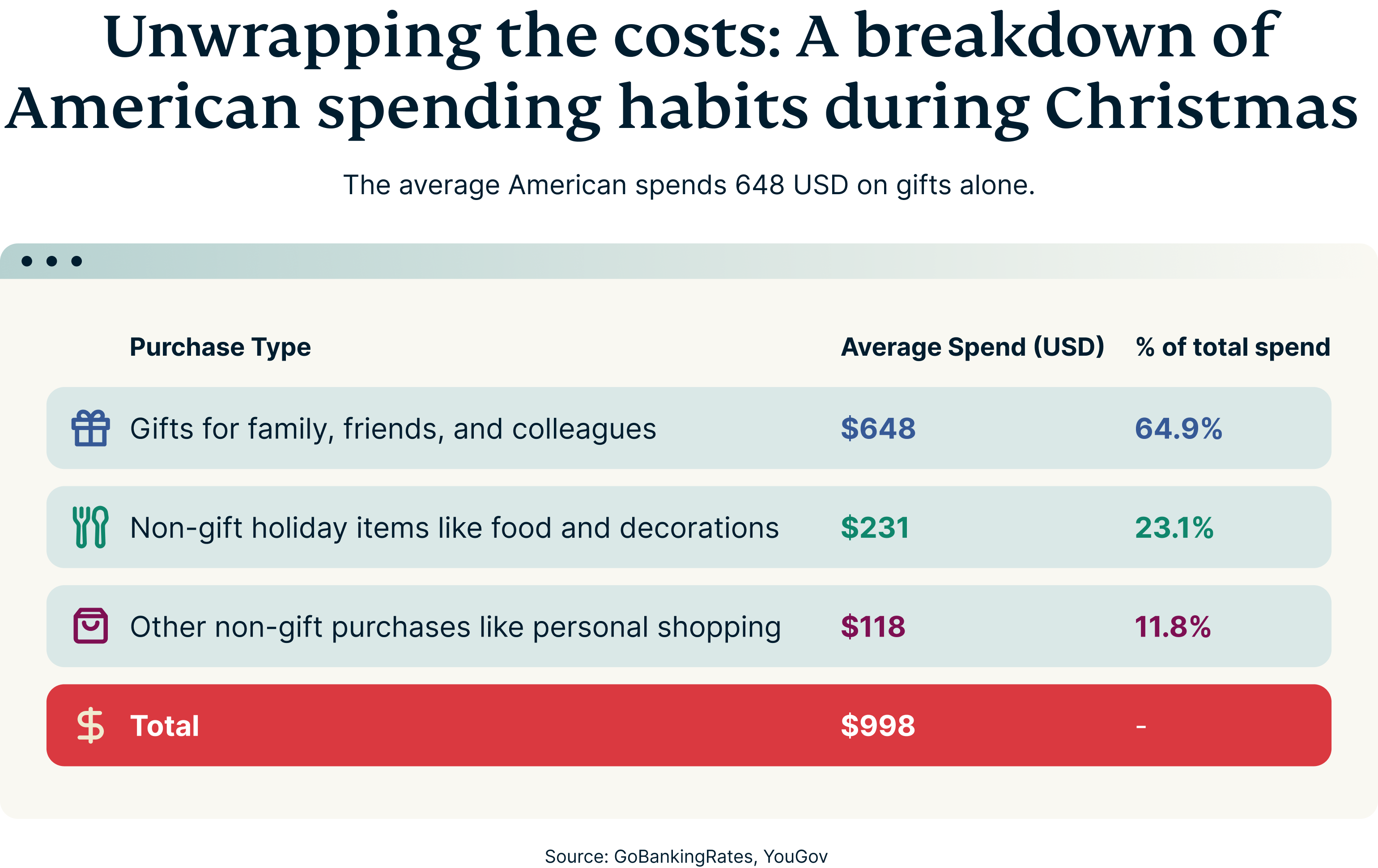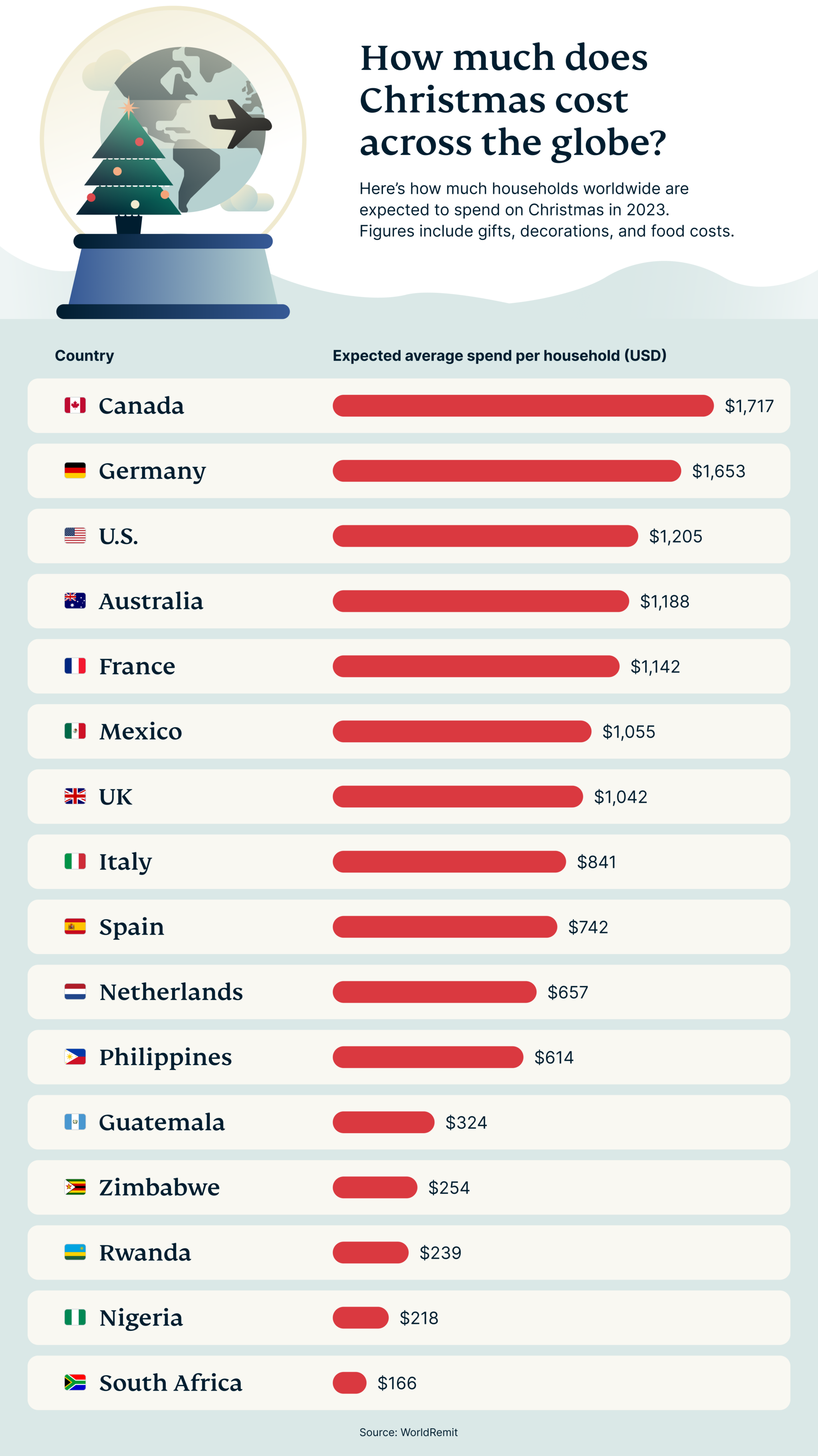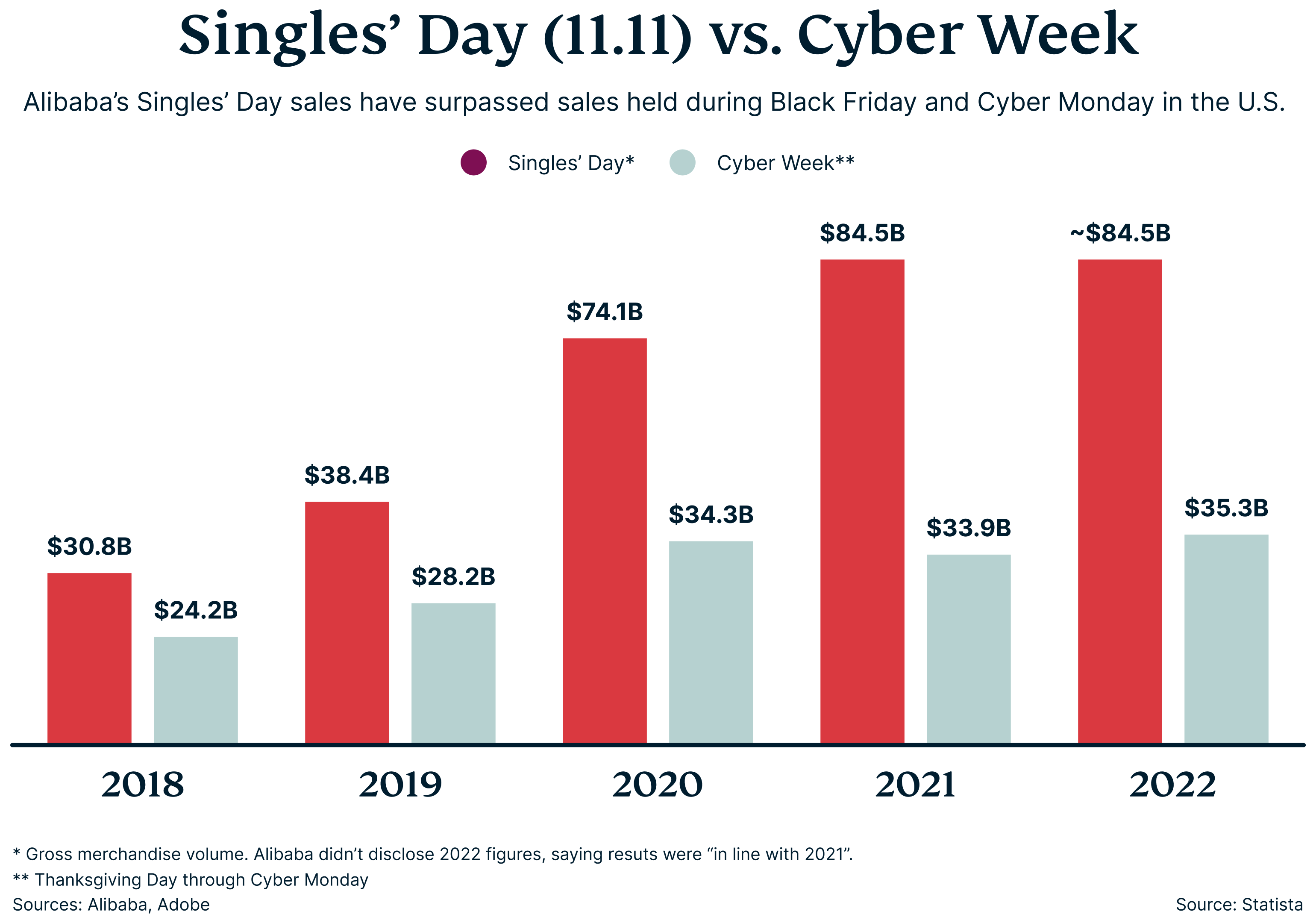[UPDATED JANUARY 2024]
- Despite economic challenges like inflation, holiday spending remains resilient. In the U.S., retail sales saw a 3.1% increase over the previous year, with online shopping growing by 6.3%.n
- Christmas leads as a key retail holiday, complemented by exclusive sale days from e-commerce platforms like Amazon and Flipkart.
n
- Retailers use strategies like time-limited deals and emotional advertising to encourage more spending during the holiday season.
n
- However, the holiday season can lead to overspending, heightened by the festive atmosphere and aggressive marketing.
n
- With the preference for online shopping, risks such as cyberattacks become more prevalent.
n
- To ensure safe online shopping, it’s advised to use trusted websites, employ a VPN (or a VPN router for your home) for secure connections, and use secure payment methods.n
- For holiday shopping in 2024, trends indicate a rise in mobile shopping and social media as major retail platforms. Additionally, the use of AI assistants and an increase in the popularity of “buy now, pay later” options are expected.
As we settle into the new year, reflection on the recent festive season reveals it wasn’t just a time for appreciation, celebration, and family gatherings, but also a period marked by significant consumer spending.
Despite economic headwinds like inflation, recent data from Mastercard shows an impressive resilience in holiday spending for the season that’s just passed. Retail sales in the U.S., excluding automotive, witnessed a 3.1% increase over the same period last year, underscoring the enduring allure of the holiday spirit.
The trend towards online shopping gained even more momentum, with a 6.3% increase in digital retail sales. Meanwhile, in-store purchases saw a modest growth of 2.2%. The apparel sector enjoyed a 2.4% rise as shoppers chose new outfits for celebratory events like office Christmas parties and New Year’s Eve bashes. The festive season’s culinary traditions were also evident, with restaurant sales jumping by 7.8% and grocery sales by 2.1%.
Adding to this picture, Adobe Analytics data revealed that Americans spent a total of 222.1 billion USD during the November 1 to December 31, 2023 alone, marking a 4.9% uptick from the previous year. This surge was driven partly by deep discounts across various categories, including electronics, toys, and apparel, and a significant rise in the use of flexible Buy Now, Pay Later (BNPL) payment options. Mobile shopping accounted for 51.1% of online sales in a notable shift, overtaking desktop shopping for the first time.
With a fresh perspective from the 2023 holiday season, where spending defied expectations, consumer focus is already shifting to the upcoming February 2024 holidays like Valentine’s Day and Lunar New Year. As these occasions approach, we decided to explore the impact of various holidays on spending patterns.
While Black Friday and Christmas are well-known shopping days in the U.S., and Valentine’s Day and Easter also draw significant attention, what about other, lesser-known holidays worldwide? How does spending on these occasions compare?
Let’s find out.
Jump to…
Infographic: How much do people spend worldwide during the holidays?
Gift-giving or wallet-emptying?
New year, new splurge
From Diwali to Singles Day and beyond
Understanding the holiday spending surge
Avoiding the pitfalls of excessive holiday spending
Checking out with care: 6 ways to protect yourself when shopping online
Bonus: What will holiday shopping in 2024 look like?
Infographic: How much do people spend worldwide during the holidays?
We examined a range of globally celebrated cultural, religious, and retail holidays, focusing on the average amount consumers typically spend during these events:

Biggest annual retail holidays
| Holiday | Period | Region (primarily) | Average spend (USD)* |
| Christmas | December | Worldwide | $1,000 per person |
| Back-to-school shopping | January – February and August – September | Worldwide | $890 per household |
| Black Friday | November | North America | $430 per person |
| Lunar New Year | January – February | Asia | $300 per person |
| Mother’s Day | March/May | Worldwide | $274 per person |
| Cyber Monday | November | North America | $218 per person |
| Easter | March – April | Worldwide | $192 per person |
| Father’s Day | June | Worldwide | $180 per person |
| Valentine’s Day | February | Worldwide | $176 per person |
| Diwali | November | India | $120 per household |
| U.S. Thanksgiving | November | North America (U.S.) | $100 per person |
| New Year’s Eve | December | Worldwide | $115 per person |
| Super Bowl | February | North America (U.S.) | $115 per person |
| Flipkart Big Billion Days | October | Asia (India) | $110 per person |
| Halloween | October | Worldwide | $109 per person |
| Afterpay Day | August | Australasia (Australia and New Zealand) | $93 per person |
| Kwanzaa | December | North America (U.S.) | $77 per person |
| El Buen Fin | November | North America (Mexico) | $60 per person |
| Amazon Prime Day | October | Worldwide | $57 per order |
| Singles’ Day (11.11) | November | Asia | $38 per order |
*Spending amounts listed are for U.S. consumers, except for Lunar New Year, Afterpay Day, Flipkart Big Billion Days, Singles’ Day, Diwali, and El Buen Fin.
Gift-giving or wallet-emptying?
A recent study by the National Retail Federation reveals a striking figure: the average American consumer spends around 1,000 USD on Christmas gifts and related holiday items each year, such as trees, ornaments, and food. Notably, over 60% of this budget is dedicated solely to buying gifts.
The average american consumer spends around 1,000 usd on christmas gifts.
To give a clearer picture, here’s a detailed breakdown:

Food, jewelry, and clothing were among the top categories for shoppers in the U.S. during the 2023 holiday period. Americans also increased their visits to bars and restaurants to celebrate the holidays, reflecting a broader trend of experiential spending.
And Americans aren’t the only ones spending big during the holiday season. Research conducted by WorldRemit, a specialist in foreign exchange and international money transfers, indicates that in 2022, households in Canada and Germany outspent their American counterparts during the Christmas season. While exact figures have yet to be released, this trend likely continued in 2023, with consumers in Canada, Germany, and France spending even more.

New year, new splurge
Holiday season spending isn’t just about the festive period. For retailers, the season continues as long as shoppers keep using their credit cards. The advent of the new year marks the beginning of a new wave of spending, with Lunar New Year and Valentine’s Day sales dominating January and February.
Earlier in 2023, following China’s lifting of pandemic-related travel restrictions, a staggering 308 million people traveled domestically during the Lunar New Year period. This led to 52 million USD in spending. E-commerce platforms also saw a significant uptick in activity. For instance, JD.com reported a 171% increase in orders on the eve of the new year compared to the previous year. With the Lunar New Year beginning on February 10 this year, it will be interesting to see how these numbers compare.
In the U.S., the Super Bowl’s influence on retail is unmistakable. In the lead-up to the game in February, sports enthusiasts typically spend around 115 USD on team merchandise, party essentials, and decorations. A study by LendingTree, an online loan platform, highlights an interesting trend: fans are increasingly splurging on new electronics like sound systems and streaming subscriptions to enhance their watch party experiences. These additional expenses significantly increase the annual expenditure associated with the event.
Valentine’s Day, often dismissed as a Hallmark holiday, has evolved into a major commercial occasion. The average American spends about 176 USD on gifts, dining out, and other activities to express their love and affection. This surge in spending is fueled by societal norms, aggressive marketing strategies, and the desire to make meaningful gestures for loved ones.
From Diwali to Singles’ Day and beyond
Diwali, one of the most important festivals in India, isn’t just a festival of lights but also a time of heightened consumer spending. Families gather to light lamps, exchange gifts, and savor festive food, often splurging on new clothes, jewelry, and home decorations. This spending surge is tied to Diwali’s symbolism of renewal and new beginnings. Retailers, recognizing this trend, entice customers with special deals and discounts, which can further fuel spending.
Singles’ Day, also known as 11.11, originated from Alibaba in China and has since become an international retail juggernaut. Celebrated on November 11, it transcends relationship status, encouraging all to indulge in self-gifting and online shopping. What began as a celebration of singledom has morphed into a colossal shopping spree. Retailers offer significant discounts on a plethora of items, from electronics to fashion, making 11.11 a formidable rival to Black Friday and Cyber Monday in sales volume.

Spurred by 11.11’s success, Southeast Asia has seen the rise of similar “double-day” sales events, including 10.10, 12.12, and 1.1. Hosted by popular platforms like Lazada, Shopee, and Zalora, these events mirror 11.11’s format, offering massive deals and drawing eager consumers.
These shopping festivals highlight the growing purchasing power in Southeast Asia and the innovative strategies e-commerce platforms employ to meet consumer demands.
In parts of South America and Mexico, El Buen Fin has emerged as a preferred shopping holiday, coinciding with other global sales events like Black Friday and Cyber Monday. In 2022, El Buen Fin raked in 1.4 billion USD from online sales, with an average spend of 60 USD on every transaction, as retailers offered attractive discounts to draw in shoppers.
The psychology of holiday spending
What drives us to spend more during the holiday season? Beyond the obvious allure of festive cheer, neuroscience offers a compelling explanation. Studies have shown that shopping can trigger the release of dopamine, a neurotransmitter associated with pleasure and reward in the brain. This dopamine rush can be particularly intense when anticipating a reward, such as snagging a good deal. A Journal of Consumer Psychology report highlights how dopamine not only enhances the shopping experience but also creates a feedback loop, making consumers eager to relive the thrill, and driving them back for more purchases.
The thrill of snagging a bargain also plays a significant role as well.The Association for Consumer Research (ACR) discovered that the excitement of getting a good deal not only feels good but also boosts self-esteem. This sensation, known as “ego-expressive,” embodies feelings of pride, intelligence, and competence.
Whether it’s a few bucks off your favorite pair of jeans or a gift with a purchase, the satisfaction of saving money–or the illusion of it—is universal, and retailers know this. This is evident in mega shopping events like Black Friday and Cyber Monday in the U.S. and Canada, and Singles’ Day (11.11) in Asia. Major e-commerce players and brands, including Amazon, Sephora, Nordstrom, and Walmart, now host their own sales events.
It’s no secret that the holiday season brings us joy, happiness, and nostalgia as we celebrate with our loved ones. Emotional advertising is another powerful tool in the retailer’s arsenal. Ads often portray idyllic holiday scenes—happy families unwrapping gifts, children delighting in new toys—evoking emotions that compel us to replicate these perfect moments. A study found that happiness and nostalgia significantly influence gift-buying behavior, making these emotional appeals especially potent during the festive season.
Beyond advertising and emotional triggers, there’s considerable societal pressure to partake in holiday festivities. The custom of reciprocating grand gifts adds to this pressure, often leading to increased spending.
Retailers also use a variety of tactics during big holiday sales events like Black Friday to encourage consumers to spend more money. One common strategy is to create a sense of urgency by offering limited-time deals or emphasizing that supplies are limited. Retailers may also offer exclusive discounts to customers who sign up for their email lists or loyalty programs.
Brick-and-mortar stores also tend to use the bait-and-switch tactic, where they advertise a deeply discounted product to draw customers in, but then try to sell them a more expensive item once they’ve entered the shop. Additionally, some retailers use doorbusters, which are deeply discounted items that are only available for a limited time or in limited quantities, to create a sense of excitement and encourage shoppers to buy quickly.
Avoiding the pitfalls of excessive holiday spending
The immediate thrill of securing a bargain can overshadow the long-term implications of excessive spending. This behavior not only strains our finances with increased debt and depleted savings but also intensifies the challenges posed by an inflationary economy, where the cost of everyday living is already escalating.
To counteract this, it’s important to recognize impulsive buying and sales tactics and strive to shift towards mindful shopping instead. Mindful shopping involves being aware of the psychological triggers retailers use and consciously deciding what, when, and how much to purchase. It’s about recognizing the difference between “want” and “need,” setting a realistic budget and sticking to it.
By adopting a mindful approach, you not only protect yourself from the financial hangover post-holidays but also find more satisfaction in your purchases. Another way to protect yourself this festive shopping season is to be vigilant against those who are trying to dupe you out of your hard-earned cash.
Checking out with care: 6 ways to protect yourself when shopping online
As the festive season approaches, the preference for online shopping is clear. The U.S. National Retail Federation reports that 58% of shoppers turn to online platforms for their festive purchases. With this significant shift towards digital storefronts, prioritizing cybersecurity is essential. The convenience of online shopping brings with it the heightened risk of scams and cyber threats, particularly during peak retail periods like the holiday season, with cybercriminals exploiting the surge in online traffic.
Being aware and taking proactive steps to safeguard your online transactions is more important than ever.
1. Only shop on trusted websites
Before committing to an online purchase, always verify the website’s URL and security certificate. Look for “https://” at the beginning of the URL and ensure the site has a valid security certificate. HTTPS encrypts your data, safeguarding sensitive information like bank details and credit card numbers.
2. Learn to spot the signs of a fake website
Fake websites surge during big holiday sales events, so it’s important to be able to identify the red flags of one. These fraudulent sites mimic legitimate retailers to scam consumers. Here’s how you can spot and avoid them:
- Check the URL carefully: Fake sites often use URLs that look similar to genuine retailer websites but may include small typos or different domain endings (e.g., .net instead of .com).
- Look for trust seals: Legitimate sites often display trust seals like VeriSign or McAfee. However, ensure these are not just images but clickable links that lead to a verification page.
- Examine the site’s design and language: Poorly designed websites with grammatical errors and low-quality images can be red flags.
- Verify contact information: Legitimate sites usually have transparent and verifiable contact information, including physical addresses and phone numbers. Be wary of sites that lack this information or provide only email contact.
- Read customer reviews: Look for website reviews on trusted third-party platforms. A complete lack of reviews or overwhelmingly negative feedback can indicate a fake site.
3. Utilize a VPN
A VPN can be a valuable tool during sales events. It not only encrypts your traffic and hides your IP address, so the site won’t be able to identify you, but it can also lead to savings due to price variations across different regions. While VPN apps protect individual devices, a VPN router—such as Aircove by ExpressVPN—extends this security to all devices in your household, including those that don’t support VPN apps, like gaming consoles and smart home devices.
4. Be wary of deals that are too good to be true
During the holiday season, it’s typical to encounter a plethora of eye-catching online deals. An iPhone discounted by 500 USD? Yes, please.
But before you click ‘add to basket,’ exercising caution. Deals that seem extraordinarily favorable are often deceptive. The holiday season’s spike in online shopping activities creates a prime opportunity for scammers to lure unsuspecting consumers. They often use unrealistically low-priced offers to entice shoppers into divulging their personal and financial information.
5. Read the retailer’s return policy
Before you make a purchase, read the website’s return policy. This will help you to understand what your options are if you’re not satisfied with your purchase. Some return policies, for example, exclude items like discounted, custom-made, or perishable items. Some websites also charge a restocking fee for returned items. Typically, this fee is a percentage of the purchase price of the item.
6. Use a credit card or payment service that offers buyer protection
Using a credit card or a payment service that offers buyer protection is one of the best ways to protect yourself from scams and fraudulent purchases during the festive season. Certain credit card companies have policies that could protect you for various reasons. For example, if you buy a product from a website or company that goes out of business before you’ve received the product, you can file a chargeback dispute with your credit card company to get your money back.
Bonus: What will holiday shopping in 2024 look like?
As we look towards the future of retail in 2024, several emerging trends are set to redefine the holiday shopping experience. Driven by advancements in technology and shifts in consumer preferences, these trends signal a new era in the retail industry.
Mobile shopping takes the lead
The convenience of smartphones has made them the go-to device for holiday shoppers. According to the U.S. Chamber of Commerce, over half of online purchases are made on a mobile phone. This has spurred retailers to optimize their websites and apps to offer seamless mobile shopping experiences, catering to the needs of consumers.
Social media as a retail hub
Social media platforms have transformed into vibrant marketplaces. In fact, a recent study conducted by Shopify revealed that 33% of consumers said they’d be likely to shop directly from Instagram, while 31% said the same for Facebook and 28% for TikTok. As a result, brands are leveraging these platforms to engage with consumers, offering personalized shopping experiences directly through social channels.
AI: The new retail assistant
Artificial intelligence is revolutionizing the retail industry. AI-driven chatbots provide 24/7 customer service, while machine learning algorithms offer tailored product recommendations, enhancing the shopping experience. According to the same Shopify survey, 74% of consumers believe that AI can help them find deals and offers, while 69% believe it makes it easier to discover new brands and products. Over 67% of consumers say that they believe AI makes it easier to get recommendations based on previous purchases.
Flexible payment options
The 2023 festive season saw a dramatic increase in BNPL payment options. According to Adobe Analytics, BNPL spending was up by 42.5% in 2023 compared to a year earlier. During November 2023, during Black Friday and Cyber Monday sales, BNPL was used for over 8.3 billion USD in spending. There’s no doubt that the popularity of these services continues to rise, offering consumers more flexibility in managing their holiday expenditures.
FAQ: About worldwide holiday spending
What are the most popular holidays for spending money worldwide?
Christmas, New Year’s Eve, and Valentine’s Day are the most popular holidays for spending money worldwide. Other popular holidays include Hanukkah, Kwanzaa, and Diwali. Black Friday, Cyber Monday, and Singles’ Day, also known as 11.11, are the most popular retail holidays.
How much do people typically spend on holidays worldwide?
The average amount people spend on holidays worldwide varies depending on the country and the holiday. However, a 2023 study conducted by Adobe Analytics revealed that Americans spent 222.1 billion USD during the November 1 to December 31 period alone.
What are some tips for saving money on holiday spending?
Here are some tips for saving money on holiday spending:
- Make a budget and stick to it.
- Shop around and compare prices.
- Take advantage of coupons and discounts.
- DIY gifts and decorations.
- Focus on the purchases that matter most.
What are some common holiday scams?
- Phishing scams: Scammers send phishing emails or create fake websites that look like legitimate websites. They then trick people into revealing their personal information, such as their credit card or social security number.
- Advance-fee scams: Scammers claim they need money upfront to cover shipping costs or other fees. However, they never deliver the product or service.
- Fake product scams: Scammers sell counterfeit or knockoff products as genuine products and reap the profits from the sale.
- Overpayment scams: In this scenario, a scammer might claim to be from a reputable company and tell the victim they’ve been overcharged for a product or service. They will then ask the victim to provide their bank account information or credit card number to refund the “overpayment”.

30-day money-back guarantee


























